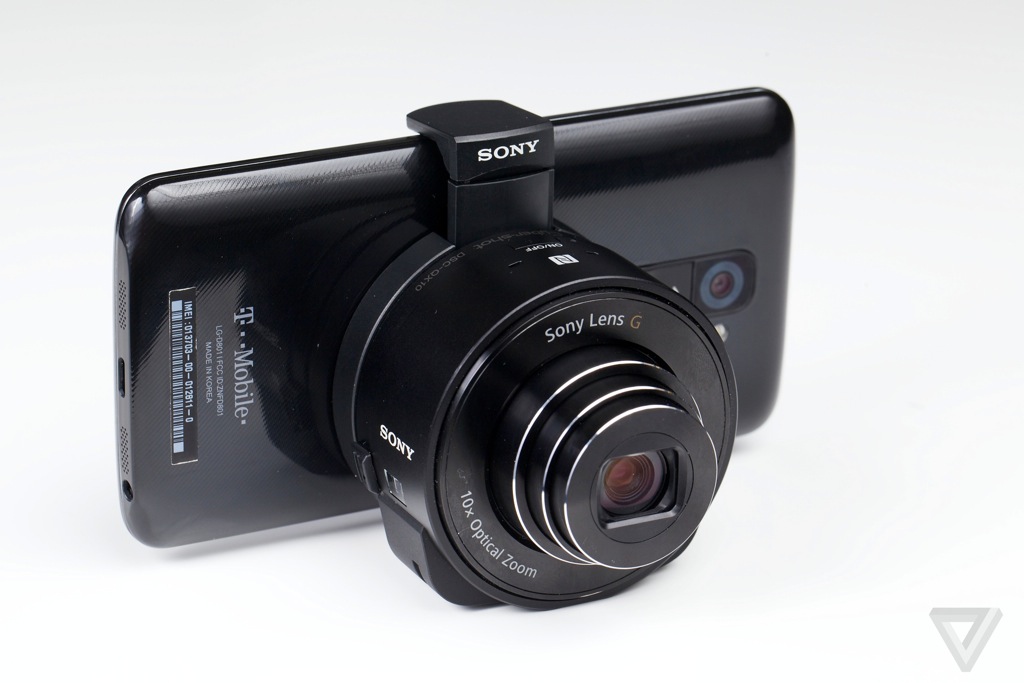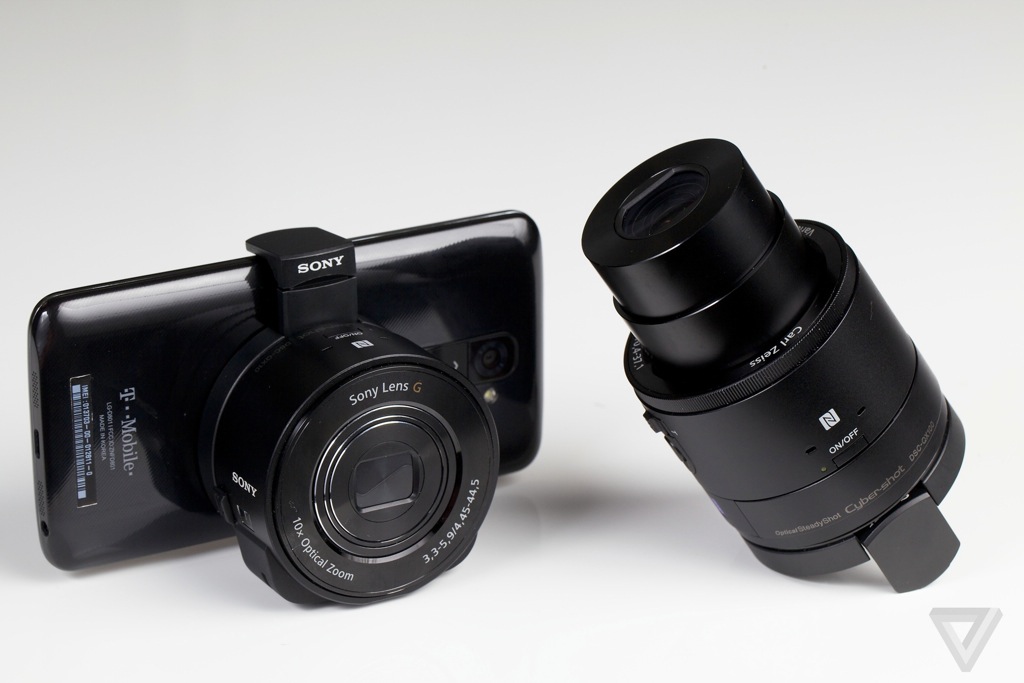Celebrity sightings are a rite of passage in New York City, and there are famous people everywhere. Yet in all my time here, the best I’d done was the empty Gotham PD cars strewn all over Wall Street between Dark Knight takes. But in the last two weeks, my luck changed.
First I saw Paul Rudd, walking in cargo shorts and a very baggy white T-shirt. Then, not 48 hours later, a scruffy Paul Giamatti walked past me on the street holding hands with his son. In both cases, I knew I had to take a picture — you’re not really a New Yorker until you’ve failed to play it super cool passing an A-list celebrity. So I reached into my pocket, and pulled out my phone. Then I reached into my bag for the Sony Cyber-shot QX100.
The $499 QX100, and its cheaper sibling, the $249 QX10, were made for this moment. They’re designed to be companions to your smartphone, offering a huge boost in image quality along with all the sharing and editing features you already use on your phone. They connect to any Android or iOS device — finally, a decent way to take pictures with your iPad — and promise the best of both a point-and-shoot and a cellphone. They look like lenses, and act like cameras.
This was my Instagram moment, I could feel it.
Ready, aim
The QX10 and QX100 are more than they seem. These matte black plastic cylinders aren’t just lenses, extensions of the round hole on the back of your smartphone; they’re cameras. Slot a microSD card into either the QX10 or the QX100, and you don’t technically need your smartphone at all — the only thing these full-fledged point-and-shoot cameras are missing is a viewfinder.
ONE PART REAL CAMERA, TWO PARTS SMARTPHONE ACCESSORY

The QX10 is the smaller of the duo, 2.5 inches in diameter and a little more than an inch tall — at about 6 ounces fully loaded, it drops perfectly into a jacket pocket. The QX100 is about twice as tall and a couple of ounces heavier, but in some ways it’s actually easier to use. My fingers often curled around the front of the QX10, and would occasionally get in the way of my shot, but the QX100 could fit my entire hand comfortably. Both devices are sturdy and durable, capable of surviving their share of dings and drops.
Both cameras are fully self-sufficient — just point the lens at your subject, zoom in and out with the switch on the left side, press the shutter right next to it, and you’re done. There's even a tripod mount, if you need it, though if you're already carrying a tripod saving space is clearly not your greatest concern.
Shooting with just the lens is completely impractical. You can’t see what you’re shooting, and like with Google Glass I found I took a lot of photos in which my subjects appeared to have no heads or where the landscape was horribly slanted. It just feels weird, too, like you’re holding out a futuristic weapon that will engulf your subject and trap them in its tiny body.
But clamp the lens to the back of your smartphone with two teeth on the included detachable mount, and it starts to feel a bit more comfortable. With one hand on the right side of my phone and the other underneath the lens, my Moto X felt like a DSLR in my hands. The clamp worked with every phone I tried, from the Galaxy Mega down to the iPhone 4S, though they’re both most comfortable on a phone about the size of the HTC One.

I don't have time to wait this long for my camera
The physical connection isn’t what really matters, though — it’s all about the software. When you use the lenses in conjunction with Sony’s PlayMemories Mobile app, your phone becomes the viewfinder, hard drive, and remote control for a much better camera than you’ve ever had on your smartphone.
There are two ways to connect the QX lenses to your phone. The easy way is NFC: on any phone that supports it, just tapping handset to lens will automatically connect the two devices. If you already have the PlayMemories Mobile app downloaded, it launches ready to shoot; if you haven’t downloaded it, you’re sent straight to the store to get it. The hard way, for any phone without NFC (notably the iPhone), is Wi-Fi — go into settings, connect arduously to the lens’s ad-hoc Wi-Fi network with an awkward alphanumeric password, then open PlayMemories Mobile and see if it took. It's this kind of clunky process, and the very same PlayMemories Mobile app, that makes Sony's Wi-Fi-enabled cameras hard to use. You're not gaining much by using a supposedly more phone-friendly device here — connecting the QX100 isn't much different from the RX100, or the NEX-6.
Either way, the process isn’t quick. It’s often 5 seconds, or even 10, before the app is open, connected, synced to the camera, and ready to take a picture. That, plus the 10 seconds it takes to clip the QX lens onto your phone in the first place, and the two or three you have to wait for every photo to transfer over Wi-Fi from lens to smartphone (more if you opt to transfer the full file instead of a 2-megapixel version), makes for a soul-crushingly slow experience. More importantly, it makes for a lot of missed shots: I wound up conspicuously following Rudd for about four blocks trying to get the Wi-Fi password right on my iPhone, and I missed Giamatti entirely. So much of a smartphone’s advantage is its speed and convenience, and Sony’s lenses undo that in really frustrating ways.
Of course, time isn’t always of the essence, and if you’re willing to do the work the QX lenses will provide you with pictures the likes of which you’ve never seen from a smartphone.

Fire
QX10
The $250 QX10 buys you… about $250 worth of point-and-shoot camera. Its 1/2.3-inch sensor is standard for a compact camera, and its G lens is decidedly low-end — there’s similar glass in Sony’s new Xperia Z1. The biggest advantage here is also the primary reason to buy any point-and-shoot: the QX10’s 10x optical zoom gives it a versatility and usability that you simply can’t get from a cellphone camera, even one like the Lumia 1020.
Photos look good, but in many situations they’re not meaningfully better than what you’d get from an iPhone 5S, a Lumia 1020, or a Galaxy S4. Sharpness and focus accuracy are a cut above, but there are still some issues with white balance and dynamic range. Once it gets above about ISO 800, pictures start to get really noisy and soft. Using the QX10, you’re really getting the best smartphone camera you could ask for — but not something utterly on another level like the QX100.
QX100
Sony’s Cyber-shot RX100 is the best point-and-shoot on the planet, and spec for spec the QX100 is identical. It has a big, 20-megapixel 1-inch sensor, a bright f/1.8 Carl Zeiss lens, 3.6x zoom, and Sony’s BIONZ processor. It has ISO sensitivity up to ISO 6400, too — it’s leaps and bounds beyond anything you’ve ever seen on Instagram.
Above all, the QX100 brings options. Thanks to the f/1.8 lens, you can shoot soft-background shots that have no business coming from your phone. You can shoot up to ISO 3200 before photos really take a hit. You can take photos where the sky, the building, and your subject are all properly exposed. Colors occasionally come out the slightest bit muted or underexposed, but with few exceptions they’re absolutely gorgeous.
Video is a slightly different beast, since the actual pixel count never really changes. 1080p video is always 1920 x 1080, whether you have 20 megapixels or 2. That said, both QX10 and QX100 shoot good video — I just don’t know that it’s meaningfully better than most decent smartphones. As with still photos, video looked occasionally muted and underexposed, but it was much more stable than what I can normally shoot with my phone.



The QX10 is slightly better than your phone — the QX100 blows it away




The RX100 and QX100 may take similar pictures, but they’re completely different experiences. With the QX100, there are all kinds of wild shots available when your phone is a remote viewfinder. Toss the camera in the air and shoot at its spinning apex; shoot video as it falls from the roof; or hide it somewhere only a tiny lens could go and shoot incredibly stealthy photos. Having a remote viewfinder isn’t totally novel, but this is a great way to do it.
The QX lenses let you take some really unique pictures
But when it comes to taking great pictures, you’ll eventually want to leave Automatic mode. As soon as you try, you’ll wish you bought an RX100 and not tried to clip a camera to your smartphone. The PlayMemories app has few settings and almost no manual control, and the ones it does offer are clumsy and laggy — there’s an Aperture priority mode on the QX100, and you can tweak white balance or set timers, but that’s basically it. There’s no mode dial, no Manual mode, nothing.
The app offers no editing tools, either, or even a way to review the photos you’ve taken. To even share a photo, you have to shoot in PlayMemories Mobile, disconnect the QX camera, open another app, dig through your camera roll, and go. Sony has an API that might eventually allow third-party apps to use the QX cameras as their own, but at the moment it’s all a lot of hassle.

A good idea, but not a great product yet
Sony did something remarkable here. It made something entirely new, and unique – there’s absolutely nothing else like the QX10 and QX100. The more I use the devices, the more I’m certain this is a good idea, too: if we can leave the smartphone features to smartphone designers, and build a camera that is solely responsible for taking gorgeous photos and then getting out of the way, both sides seem better off. I’d rather have those pieces be seamlessly and perfectly connected in one body, but for reasons both physics- and market-driven, that’s still a pipe dream. This is the feasible best of both worlds, combined.
It’s that combination that’s the problem. Yes, you take great pictures with the QX100 (less so the QX10, which is far more pocketable but ultimately much less worth the price). Yes, you can share pictures on Instagram and Flickr. But taking pictures, editing pictures, and even getting the whole machine up and running is so complicated and time-consuming that I have trouble imagining most people will go through the process more than a few times. If you’re desperate for better pictures than your smartphone can provide, there are plenty of great cameras for that. Small ones, ones that cost $249 or $499, even ones that connect to your smartphone in their own clunky way.
Sony might just be ahead of its time, and once it figures out how to make taking pictures with the QX lenses into truly a point-and-shoot experience, I expect to see this kind of camera attached to the back of every smartphone on the planet. Mine included. But the next time I find myself walking toward Paul Giamatti on the streets of Brooklyn, I’m going to be reaching for my phone, and only my phone. It’ll do for now.
Photography by Michael Shane
An average point-and-shoot isn't actually that much better than your phone anymore
Sony did something remarkable here. It made something entirely new, and unique – there’s absolutely nothing else like the QX10 and QX100. The more I use the devices, the more I’m certain this is a good idea, too: if we can leave the smartphone features to smartphone designers, and build a camera that is solely responsible for taking gorgeous photos and then getting out of the way, both sides seem better off. I’d rather have those pieces be seamlessly and perfectly connected in one body, but for reasons both physics- and market-driven, that’s still a pipe dream. This is the feasible best of both worlds, combined.
It’s that combination that’s the problem. Yes, you take great pictures with the QX100 (less so the QX10, which is far more pocketable but ultimately much less worth the price). Yes, you can share pictures on Instagram and Flickr. But taking pictures, editing pictures, and even getting the whole machine up and running is so complicated and time-consuming that I have trouble imagining most people will go through the process more than a few times. If you’re desperate for better pictures than your smartphone can provide, there are plenty of great cameras for that. Small ones, ones that cost $249 or $499, even ones that connect to your smartphone in their own clunky way.
Sony might just be ahead of its time, and once it figures out how to make taking pictures with the QX lenses into truly a point-and-shoot experience, I expect to see this kind of camera attached to the back of every smartphone on the planet. Mine included. But the next time I find myself walking toward Paul Giamatti on the streets of Brooklyn, I’m going to be reaching for my phone, and only my phone. It’ll do for now.
Photography by Michael Shane
:format(webp)/cdn.vox-cdn.com/uploads/chorus_asset/file/12803195/IMG_3492-1024.1419979944.jpg)
:format(webp)/cdn.vox-cdn.com/uploads/chorus_asset/file/12803195/IMG_3492-1024.1419979944.jpg)
Share this story